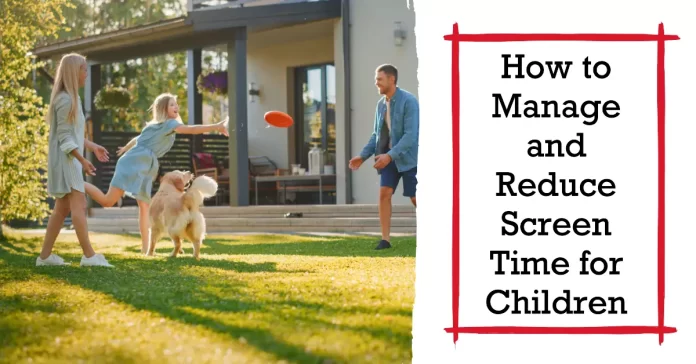
In today’s digital era, managing and reducing screen time for children has become a pressing concern for parents and caregivers. Excessive screen time negatively impacts children’s physical health, mental well-being, and overall development. This article provides practical techniques and strategies to strike a healthy balance, ensuring children’s well-rounded growth and promoting meaningful engagement beyond screens.
Here are Effective Strategies for Reducing Children’s Screen Time
Set clear boundaries
Establish specific rules and limits around screen time, such as designating certain hours or duration, to create a structured routine. Communicate these boundaries clearly to your child and ensure they understand the expectations. Consistency is the key to enforcing these boundaries and reinforcing the importance of balancing screen time with other activities.Encourage alternative activities
Provide appealing alternatives to screen time that capture your child’s interest and promote their overall development. Encourage outdoor play, such as bike rides, sports, or nature exploration. Encourage hobbies like drawing, painting, playing a musical instrument, or building with blocks. Encourage reading books that stimulate imagination and language skills. Plan family activities like board games, puzzles, or cooking together, creating meaningful connections and fun experiences.Lead by example
Be a positive role model for your child by practicing healthy screen habits. Limit your own screen time and prioritize face-to-face interactions. When engaging with screens, demonstrate responsible and purposeful usage. Engage in activities together that do not involve screens, such as taking walks, having conversations, or pursuing personal hobbies. Show your child the importance of balance and moderation in using technology.Create tech-free zones
Designate specific areas in your home, such as bedrooms, dining areas, or family gathering spaces, as screen-free zones. Establishing these boundaries helps create a conducive environment for face-to-face interactions and quality time with loved ones. Ensure that screens are not allowed during meals, family discussions, or before bedtime to foster healthy habits and meaningful connections.Utilize parental control tools
Take advantage of parental control features on devices, or consider using third-party apps to monitor and manage your child’s screen time effectively. These tools can help set time limits, block inappropriate content and track usage. Explore the options available on your child’s devices and choose tools that align with your values and goals.Foster open communication
Have regular and open conversations with your child about the benefits and drawbacks of excessive screen time. Help them understand the potential effects on their health, relationships, and overall well-being. Involve them in setting screen time limits and have a sense of ownership and responsibility. Cheer them to share their concerns, challenges, and experiences related to screen time and work together to find solutions that meet everyone’s needs.Plan screen-free activities
Schedule screen-free periods, such as technology-free weekends or dedicated family nights. Use this time to engage in activities that promote bonding, creativity, and exploration. Motivate your child with ideas for screen-free activities and involve them in planning and organizing these special times.Engage in joint activities
Encourage shared activities with your child that do not involve screens. Engage in physical activities together, such as playing sports, hiking, or practicing yoga. Encourage creativity through art projects, building with blocks or Legos, or cooking and baking. Explore your child’s interests and engage in activities that foster their passion and curiosity.Explore educational content
While limiting recreational screen time, encourage your child to engage with educational apps, websites, or programs that provide valuable learning experiences. Look for apps or platforms that offer age-appropriate educational content, interactive learning games, or informative videos. Discuss the educational value of these resources with your child and set limits to ensure a balanced approach.Establish a bedtime routine
Set a consistent and screen-free bedtime routine to promote quality sleep. The blue light emitted by screens can interfere with sleep patterns, so it’s essential to establish a technology.
Final Words
Parents and caregivers can create a healthy digital environment for their children by implementing effective screen time management techniques. Setting clear boundaries, encouraging alternative activities, and fostering open communication can help reduce excessive screen time and promote a more balanced lifestyle. Remember, it’s not about eliminating screens but finding the right balance that supports children’s overall well-being and allows them to explore diverse interests and experiences. We can help our children develop healthy habits, enhance their creativity, and foster meaningful connections with the world around them.
Frequently Asked Questions (FAQs)
Why is it essential to manage and reduce screen time for children?
Managing and reducing screen time for children is crucial to promote their overall well-being, physical health, social development, and academic performance.
What is the recommended amount of screen time for children of different age groups?
The American Academy of Pediatrics recommends limiting screen time to 1 hour per day for children aged 2-5 and establishing consistent limits for older children, balancing their screen time with other healthy activities.
What are the potential risks associated with excessive screen time for children?
Excessive screen time can lead to sedentary behavior, poor sleep patterns, reduced physical activity, developmental delays, and increased risks of obesity, attention problems, and cyberbullying.
How can parents and caregivers effectively manage and reduce their child’s screen time?
Parents can establish screen time rules, create device-free zones, provide alternative activities, encourage outdoor play, engage in family activities, and serve as positive role models by limiting their screen time.
Are there any recommended strategies to help children develop a healthy relationship with screens?
Encouraging open communication, setting clear boundaries, using parental control tools, promoting media literacy, encouraging quality content choices, and fostering a balance between screen time and other activities can help children develop a healthy relationship with screens.









